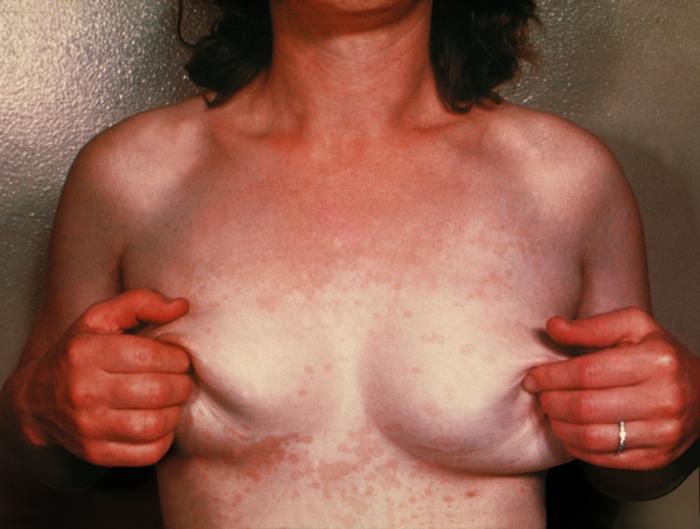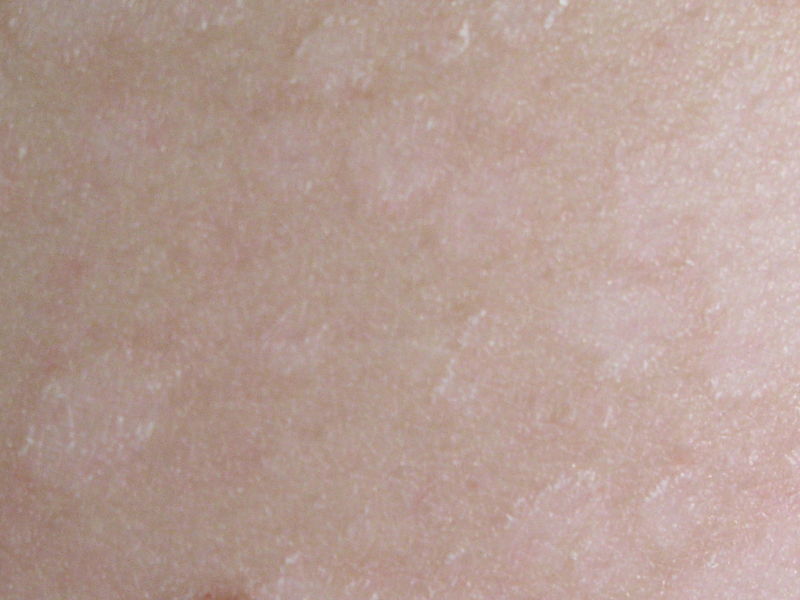Tinea versicolor
| Tinea versicolor | |
 | |
|---|---|
| ICD-10 | B36.0 |
| ICD-9 | 111.0 |
| DiseasesDB | 10071 |
| MedlinePlus | 001465 |
| eMedicine | derm/423 |
|
WikiDoc Resources for Tinea versicolor |
|
Articles |
|---|
|
Most recent articles on Tinea versicolor Most cited articles on Tinea versicolor |
|
Media |
|
Powerpoint slides on Tinea versicolor |
|
Evidence Based Medicine |
|
Clinical Trials |
|
Ongoing Trials on Tinea versicolor at Clinical Trials.gov Trial results on Tinea versicolor Clinical Trials on Tinea versicolor at Google
|
|
Guidelines / Policies / Govt |
|
US National Guidelines Clearinghouse on Tinea versicolor NICE Guidance on Tinea versicolor
|
|
Books |
|
News |
|
Commentary |
|
Definitions |
|
Patient Resources / Community |
|
Patient resources on Tinea versicolor Discussion groups on Tinea versicolor Patient Handouts on Tinea versicolor Directions to Hospitals Treating Tinea versicolor Risk calculators and risk factors for Tinea versicolor
|
|
Healthcare Provider Resources |
|
Causes & Risk Factors for Tinea versicolor |
|
Continuing Medical Education (CME) |
|
International |
|
|
|
Business |
|
Experimental / Informatics |
Editor-In-Chief: C. Michael Gibson, M.S., M.D. [1]; Associate Editor(s)-in-Chief: Kiran Singh, M.D. [2]
Overview
Tinea versicolor or pityriasis versicolor is a common skin infection caused by the yeast Malassezia furfur (formerly termed Pityrosporum ovale). This yeast is normally found on the human skin and only becomes troublesome under certain circumstances, such as a warm and humid environment.
Symptoms
The symptoms of this condition include:
- Generally oval or irregularly-shaped spots of 1/4 to 1 inch in diameter, often merging together to form a larger patch
- Occasional fine scaling of the skin producing a very superficial ash-like scale
- Pale, dark tan, or pink in color, with a reddish undertone that can darken when the patient is overheated, such as in a hot shower or during/after exercise
- Sharp border
These spots commonly affect the back, underarm, upper arm, chest, lower legs, and neck. Occasionally it can also be present on the face. The yeasts can often be seen under the microscope within the lesions and typically have a so called "spaghetti and meat ball appearance" as the round yeasts produce filaments.
In people with dark skin tones, pigmentary changes such as hypopigmentation (loss of color) are common, while in those with lighter skin color, hyperpigmentation (increase in skin color) are more common. These discolorations have led to the term "sun fungus".
Diagnosis
Physical Examination
Skin
Trunk
-
Pityriasis versicolor. With permission from Dermatology Atlas.[1]
-
Pityriasis versicolor. With permission from Dermatology Atlas.[1]
-
Pityriasis versicolor. With permission from Dermatology Atlas.[1]
-
Pityriasis versicolor. With permission from Dermatology Atlas.[1]
-
Pityriasis versicolor. With permission from Dermatology Atlas.[1]
-
Pityriasis versicolor. With permission from Dermatology Atlas.[1]
-
Pityriasis versicolor. With permission from Dermatology Atlas.[1]
-
Pityriasis versicolor. With permission from Dermatology Atlas.[1]
-
Pityriasis versicolor. With permission from Dermatology Atlas.[1]
-
Pityriasis versicolor. With permission from Dermatology Atlas.[1]
-
Pityriasis versicolor. With permission from Dermatology Atlas.[1]
-
Pityriasis versicolor. With permission from Dermatology Atlas.[1]
-
Pityriasis versicolor. With permission from Dermatology Atlas.[1]
-
Pityriasis versicolor. With permission from Dermatology Atlas.[1]
-
Pityriasis versicolor. With permission from Dermatology Atlas.[1]
-
Pityriasis versicolor. With permission from Dermatology Atlas.[1]
-
Pityriasis versicolor. With permission from Dermatology Atlas.[1]
-
Pityriasis versicolor. With permission from Dermatology Atlas.[1]
-
Pityriasis versicolor. With permission from Dermatology Atlas.[1]
-
Pityriasis versicolor. With permission from Dermatology Atlas.[1]
-
Pityriasis versicolor. With permission from Dermatology Atlas.[1]
-
Pityriasis versicolor. With permission from Dermatology Atlas.[1]
-
Pityriasis versicolor. With permission from Dermatology Atlas.[1]
-
Pityriasis versicolor. With permission from Dermatology Atlas.[1]
-
Pityriasis versicolor. With permission from Dermatology Atlas.[1]
-
Pityriasis versicolor. With permission from Dermatology Atlas.[1]
-
Pityriasis versicolor. With permission from Dermatology Atlas.[1]
-
Pityriasis versicolor. With permission from Dermatology Atlas.[1]
-
Pityriasis versicolor. With permission from Dermatology Atlas.[1]
-
Pityriasis versicolor. With permission from Dermatology Atlas.[1]
-
Pityriasis versicolor. With permission from Dermatology Atlas.[1]
-
Pityriasis versicolor. With permission from Dermatology Atlas.[1]
-
Pityriasis versicolor. With permission from Dermatology Atlas.[1]
-
Pityriasis versicolor. With permission from Dermatology Atlas.[1]
-
Pityriasis versicolor. With permission from Dermatology Atlas.[1]
-
Pityriasis versicolor. With permission from Dermatology Atlas.[1]
-
Pityriasis versicolor. With permission from Dermatology Atlas.[1]
-
Pityriasis versicolor. With permission from Dermatology Atlas.[1]
-
Pityriasis versicolor. With permission from Dermatology Atlas.[1]
-
Pityriasis versicolor. With permission from Dermatology Atlas.[1]
-
Pityriasis versicolor. With permission from Dermatology Atlas.[1]
-
Pityriasis versicolor. With permission from Dermatology Atlas.[1]
-
Pityriasis versicolor. With permission from Dermatology Atlas.[1]
-
Pityriasis versicolor. With permission from Dermatology Atlas.[1]
-
Pityriasis versicolor. With permission from Dermatology Atlas.[1]
-
Pityriasis versicolor. With permission from Dermatology Atlas.[1]
-
Pityriasis versicolor. With permission from Dermatology Atlas.[1]
-
Pityriasis versicolor. With permission from Dermatology Atlas.[1]
-
Pityriasis versicolor. With permission from Dermatology Atlas.[1]
-
Pityriasis versicolor. With permission from Dermatology Atlas.[1]
-
Pityriasis versicolor. With permission from Dermatology Atlas.[1]
-
Pityriasis versicolor. With permission from Dermatology Atlas.[1]
-
Pityriasis versicolor. With permission from Dermatology Atlas.[1]
-
Pityriasis versicolor. With permission from Dermatology Atlas.[1]
-
Pityriasis versicolor. With permission from Dermatology Atlas.[1]
-
Pityriasis versicolor. With permission from Dermatology Atlas.[1]
-
Pityriasis versicolor. With permission from Dermatology Atlas.[1]
Extremities
-
Pityriasis versicolor. With permission from Dermatology Atlas.[1]
-
Pityriasis versicolor. With permission from Dermatology Atlas.[1]
-
Pityriasis versicolor. With permission from Dermatology Atlas.[1]
-
Pityriasis versicolor. With permission from Dermatology Atlas.[1]
-
Pityriasis versicolor. With permission from Dermatology Atlas.[1]
-
Pityriasis versicolor. With permission from Dermatology Atlas.[1]
Prevalence
Tinea versicolor is a common condition. It is estimated that 2 to 8% of the population of the United States has it. This skin disease commonly affects adolescents and young adults, especially in warm and humid climates. It is thought that the yeast feeds on skin oils (lipids) as well as dead skin cells.

Treatment
Treatments for tinea versicolor include:
- Topical antifungal medications - containing either 2.5% selenium sulfide (Selsun® shampoo in UK, but not Selsun Blue which contains only 1%) or 2% ketoconazole (Nizoral® ointment and shampoo) applied to dry skin and washed off after 10 minutes, repeated daily for 2 weeks. Other topical antifungal agents such as clotrimazole, miconazole or terbinafine are less widely recommended. Additionally, hydrogen peroxide has been known to lessen symptoms, and on certain occasions, remove the problem.
- Oral antifungal prescription only medications include 400 mg of ketoconazole or fluconazole in a single dose, or ketoconazole 200 mg daily for 7 days, or itraconazole 400 mg daily for 3-7 days. The single-dose regimens can be made more effective by having the patient exercise 1-2 hours after the dose, to induce sweating. The sweat is allowed to evaporate, and showering is delayed for a day, leaving a film of the medication on the skin.
- Recurrence is common and may be reduced by intermittent application of topical agents (such as tea tree oil) or adding a small amount of anti-dandruff shampoo to water used for bathing.
Antimicrobial Regimen
- Tinea versicolor
- Preferred regimen: Ketoconazole 400 mg PO single dose OR 200 mg q24h for 7 days OR 2% cream once q24h for 2 weeks
- Alternative regimen: Fluconazole 400 mg PO single dose OR Itraconazole 400 mg PO q24h for 3–7 days
External links
de:Pityriasis versicolor nl:Pityriasis versicolor sv:Pityriasis versicolor sr:Tinea_versicolor
Template:WH Template:WikiDoc Sources
- ↑ 1.00 1.01 1.02 1.03 1.04 1.05 1.06 1.07 1.08 1.09 1.10 1.11 1.12 1.13 1.14 1.15 1.16 1.17 1.18 1.19 1.20 1.21 1.22 1.23 1.24 1.25 1.26 1.27 1.28 1.29 1.30 1.31 1.32 1.33 1.34 1.35 1.36 1.37 1.38 1.39 1.40 1.41 1.42 1.43 1.44 1.45 1.46 1.47 1.48 1.49 1.50 1.51 1.52 1.53 1.54 1.55 1.56 1.57 1.58 1.59 1.60 1.61 1.62 "Dermatology Atlas".
![Pityriasis versicolor. With permission from Dermatology Atlas.[1]](/images/e/e8/Pityriasis_versicolor01.jpg)
![Pityriasis versicolor. With permission from Dermatology Atlas.[1]](/images/3/35/Pityriasis_versicolor02.jpg)
![Pityriasis versicolor. With permission from Dermatology Atlas.[1]](/images/7/70/Pityriasis_versicolor04.jpg)
![Pityriasis versicolor. With permission from Dermatology Atlas.[1]](/images/6/64/Pityriasis_versicolor06.jpg)
![Pityriasis versicolor. With permission from Dermatology Atlas.[1]](/images/1/1a/Pityriasis_versicolor07.jpg)
![Pityriasis versicolor. With permission from Dermatology Atlas.[1]](/images/6/62/Pityriasis_versicolor08.jpg)
![Pityriasis versicolor. With permission from Dermatology Atlas.[1]](/images/3/3c/Pityriasis_versicolor09.jpg)
![Pityriasis versicolor. With permission from Dermatology Atlas.[1]](/images/6/6e/Pityriasis_versicolor11.jpg)
![Pityriasis versicolor. With permission from Dermatology Atlas.[1]](/images/f/fc/Pityriasis_versicolor12.jpg)
![Pityriasis versicolor. With permission from Dermatology Atlas.[1]](/images/0/0b/Pityriasis_versicolor13.jpg)
![Pityriasis versicolor. With permission from Dermatology Atlas.[1]](/images/5/5d/Pityriasis_versicolor15.jpg)
![Pityriasis versicolor. With permission from Dermatology Atlas.[1]](/images/0/05/Pityriasis_versicolor16.jpg)
![Pityriasis versicolor. With permission from Dermatology Atlas.[1]](/images/2/29/Pityriasis_versicolor17.jpg)
![Pityriasis versicolor. With permission from Dermatology Atlas.[1]](/images/a/a8/Pityriasis_versicolor18.jpg)
![Pityriasis versicolor. With permission from Dermatology Atlas.[1]](/images/4/4a/Pityriasis_versicolor19.jpg)
![Pityriasis versicolor. With permission from Dermatology Atlas.[1]](/images/8/88/Pityriasis_versicolor20.jpg)
![Pityriasis versicolor. With permission from Dermatology Atlas.[1]](/images/e/eb/Pityriasis_versicolor23.jpg)
![Pityriasis versicolor. With permission from Dermatology Atlas.[1]](/images/f/f5/Pityriasis_versicolor24.jpg)
![Pityriasis versicolor. With permission from Dermatology Atlas.[1]](/images/c/c1/Pityriasis_versicolor25.jpg)
![Pityriasis versicolor. With permission from Dermatology Atlas.[1]](/images/d/db/Pityriasis_versicolor26.jpg)
![Pityriasis versicolor. With permission from Dermatology Atlas.[1]](/images/7/73/Pityriasis_versicolor27.jpg)
![Pityriasis versicolor. With permission from Dermatology Atlas.[1]](/images/b/bf/Pityriasis_versicolor28.jpg)
![Pityriasis versicolor. With permission from Dermatology Atlas.[1]](/images/a/a6/Pityriasis_versicolor29.jpg)
![Pityriasis versicolor. With permission from Dermatology Atlas.[1]](/images/6/6c/Pityriasis_versicolor30.jpg)
![Pityriasis versicolor. With permission from Dermatology Atlas.[1]](/images/6/6e/Pityriasis_versicolor31.jpg)
![Pityriasis versicolor. With permission from Dermatology Atlas.[1]](/images/b/b6/Pityriasis_versicolor32.jpg)
![Pityriasis versicolor. With permission from Dermatology Atlas.[1]](/images/d/d6/Pityriasis_versicolor33.jpg)
![Pityriasis versicolor. With permission from Dermatology Atlas.[1]](/images/8/84/Pityriasis_versicolor34.jpg)
![Pityriasis versicolor. With permission from Dermatology Atlas.[1]](/images/4/49/Pityriasis_versicolor35.jpg)
![Pityriasis versicolor. With permission from Dermatology Atlas.[1]](/images/1/1d/Pityriasis_versicolor36.jpg)
![Pityriasis versicolor. With permission from Dermatology Atlas.[1]](/images/5/57/Pityriasis_versicolor38.jpg)
![Pityriasis versicolor. With permission from Dermatology Atlas.[1]](/images/4/46/Pityriasis_versicolor39.jpg)
![Pityriasis versicolor. With permission from Dermatology Atlas.[1]](/images/2/21/Pityriasis_versicolor40.jpg)
![Pityriasis versicolor. With permission from Dermatology Atlas.[1]](/images/3/3f/Pityriasis_versicolor41.jpg)
![Pityriasis versicolor. With permission from Dermatology Atlas.[1]](/images/d/d9/Pityriasis_versicolor42.jpg)
![Pityriasis versicolor. With permission from Dermatology Atlas.[1]](/images/c/cd/Pityriasis_versicolor43.jpg)
![Pityriasis versicolor. With permission from Dermatology Atlas.[1]](/images/a/a4/Pityriasis_versicolor44.jpg)
![Pityriasis versicolor. With permission from Dermatology Atlas.[1]](/images/8/83/Pityriasis_versicolor45.jpg)
![Pityriasis versicolor. With permission from Dermatology Atlas.[1]](/images/6/6f/Pityriasis_versicolor46.jpg)
![Pityriasis versicolor. With permission from Dermatology Atlas.[1]](/images/f/f2/Pityriasis_versicolor47.jpg)
![Pityriasis versicolor. With permission from Dermatology Atlas.[1]](/images/e/e2/Pityriasis_versicolor48.jpg)
![Pityriasis versicolor. With permission from Dermatology Atlas.[1]](/images/5/56/Pityriasis_versicolor49.jpg)
![Pityriasis versicolor. With permission from Dermatology Atlas.[1]](/images/4/4e/Pityriasis_versicolor52.jpg)
![Pityriasis versicolor. With permission from Dermatology Atlas.[1]](/images/b/bc/Pityriasis_versicolor53.jpg)
![Pityriasis versicolor. With permission from Dermatology Atlas.[1]](/images/3/30/Pityriasis_versicolor54.jpg)
![Pityriasis versicolor. With permission from Dermatology Atlas.[1]](/images/1/10/Pityriasis_versicolor55.jpg)
![Pityriasis versicolor. With permission from Dermatology Atlas.[1]](/images/5/5a/Pityriasis_versicolor56.jpg)
![Pityriasis versicolor. With permission from Dermatology Atlas.[1]](/images/d/dd/Pityriasis_versicolor57.jpg)
![Pityriasis versicolor. With permission from Dermatology Atlas.[1]](/images/6/6e/Pityriasis_versicolor58.jpg)
![Pityriasis versicolor. With permission from Dermatology Atlas.[1]](/images/c/c3/Pityriasis_versicolor59.jpg)
![Pityriasis versicolor. With permission from Dermatology Atlas.[1]](/images/8/8c/Pityriasis_versicolor60.jpg)
![Pityriasis versicolor. With permission from Dermatology Atlas.[1]](/images/7/74/Pityriasis_versicolor61.jpg)
![Pityriasis versicolor. With permission from Dermatology Atlas.[1]](/images/3/3d/Pityriasis_versicolor62.jpg)
![Pityriasis versicolor. With permission from Dermatology Atlas.[1]](/images/e/e3/Pityriasis_versicolor63.jpg)
![Pityriasis versicolor. With permission from Dermatology Atlas.[1]](/images/9/98/Pityriasis_versicolor64.jpg)
![Pityriasis versicolor. With permission from Dermatology Atlas.[1]](/images/0/06/Pityriasis_versicolor05.jpg)
![Pityriasis versicolor. With permission from Dermatology Atlas.[1]](/images/c/c9/Pityriasis_versicolor50.jpg)
![Pityriasis versicolor. With permission from Dermatology Atlas.[1]](/images/2/2a/Pityriasis_versicolor03.jpg)
![Pityriasis versicolor. With permission from Dermatology Atlas.[1]](/images/e/e6/Pityriasis_versicolor10.jpg)
![Pityriasis versicolor. With permission from Dermatology Atlas.[1]](/images/d/d2/Pityriasis_versicolor21.jpg)
![Pityriasis versicolor. With permission from Dermatology Atlas.[1]](/images/7/73/Pityriasis_versicolor22.jpg)
![Pityriasis versicolor. With permission from Dermatology Atlas.[1]](/images/e/e8/Pityriasis_versicolor37.jpg)
![Pityriasis versicolor. With permission from Dermatology Atlas.[1]](/images/6/60/Pityriasis_versicolor51.jpg)